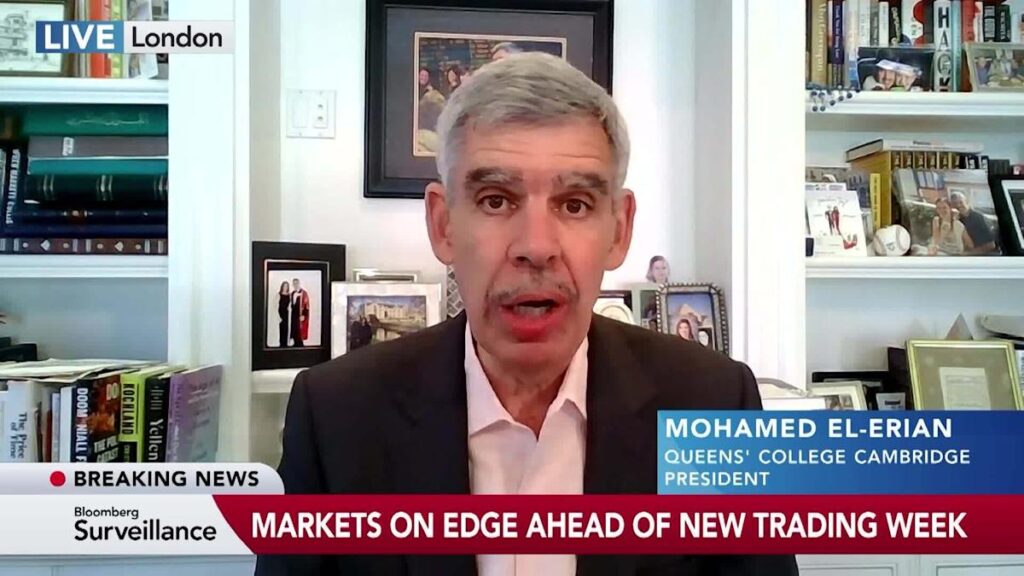(Bloomberg) — All across Wall Street, on the trading desks and in corporate C-suites, among hedge-fund managers and bond dealers, there’s a growing unease that one day soon, Donald Trump might just end up breaking not only the economy, but also key parts of the financial markets.
Most Read from Bloomberg
After equity markets in Asia and Europe plummeted for a third day, the S&P 500 Index in the US ended the day down just 0.2%, slowing the worst slide since the pandemic hit the US in 2020.
But beneath the surface, anxiety continued to send unusual convulsions through markets, causing benchmarks in stocks and bonds to swing wildly, and often in conflict, between pricing in recession fears to betting the financial toll will force Trump to back down. Shortly before 10 a.m. in New York, stocks started surging, bouncing more than 8% off their lows in a matter of minutes, as rumors swirled on Wall Street trading desks that Trump would delay his tariffs. Stocks gave up the gains just as quickly as the speculation was debunked.
In the bond market, Treasuries traded in ways that defied easy explanations, with yields rising relentlessly through the day. That pushed 10-year yields up nearly 0.2 percentage points to 4.19%, sowing multiple theories — including fears of an overseas buyers’ strike at auctions, concern the federal debt will jump as trade stalls and worrisome signs of dash-for-cash liquidations.
Meantime, investors scoured funding markets for signs of any disruptions on concern big banks and other dealers are at risk of getting hit.
“It’s extraordinarily hard to trade this market. It’s stressful. It’s very messy,” said Julian Brigden, co-founder of Macro Intelligence 2 Partners. “People cannot wrap their heads around the idea that the world is different now.”
Subscribe to the Bloomberg Daybreak podcast on Apple, Spotify or anywhere you listen.
Analysts and investors were quick to downplay any immediate risk to the global financial system, even after global stock losses neared $10 trillion over the past three days. But they pointed to signs of strain — like frozen corporate debt markets and a jump in gauges of default risk — that have piled up as the economic outlook darkened rapidly across the globe.
Raising Alarms
On Wall Street, prominent figures like the money managers Bill Ackman and Boaz Weinstein and JPMorgan Chase & Co. CEO Jamie Dimon have all started raising alarms about the mounting risks.
But Trump and his aides have registered little concern. Over the weekend, his economic advisers pooh-poohed the market’s drop last week and expressed confidence that higher tariffs will ultimately rejuvenate the US economy. Trump has been similarly nonplussed, touting the benefits of the recent slide in oil prices and calling instead of Fed Chair Jerome Powell to cut rates.
Late Monday, he said he isn’t considering pausing his tariffs but is open to negotiating with trading partners.
That capped what amounted to yet another exhausting, topsy-turvy day in financial markets, and one where traders were looking for any hint, however small or fleeting, of where the markets are headed only to end up with little clarity.
Josh Kutin, head of multi-asset solutions for North America at Columbia Threadneedle Investments, said investors were hoping for some better signals from Trump.
“It’s a reflection on not only how poorly the market has obviously digested the tariff news,” he said. “So long as it’s hard to find a path to a resolution, we will most likely continue to see high volatility and big swings on rumors and comments.”
‘Litmus Test’
That was evident just 15 minutes into the trading day Monday, when rumors of a tariff-hike pause sent the S&P 500 Index jumped, only to fade once it became clear that wasn’t the case and Trump threatened to retaliate against China. The volatility in the bond market were also just as severe, with Treasury yields surging even as concern about a recession fuel bets that the Fed will cut rates.
It wasn’t entirely clear why Treasury yields spiked the way they did. Ian Lyngen, the head of US rates strategy for BMO Capital Markets, said there are several explanations being bandied about, including taking profits from the recent rally and raising cash to redeploy it when markets steady. One reassuring sign, he said, was the lack of stress in the overnight repo market, indicating it wasn’t a sign of a liquidity strain.
“The real litmus test of this read will be to see how the market trades during the overnight session,” he wrote Monday. “In the event that the Treasury market rally resumes, investors will be quick to write-off Monday’s price action as an anomaly as opposed to a breakdown of the ‘risk-on, risk-off’ dynamic.”
While the US stock selloff eased considerably, there were few signs of outright optimism. Nevertheless, the bounces in stock prices in the US reassured some traders, who saw it as a sign that investors were willing to swoop back in and haven’t fully retrenched in fear.
“The positive vibes proved to be fleeting,” said Steve Sosnick, chief strategist at Interactive Brokers. “But it proved how desperate traders are for any sort of tariff relief.”
–With assistance from Levin Stamm, Beth Mellor, Phil Kuntz, Lynn Thomasson, Sagarika Jaisinghani, Ram Anand, Tan Hwee Ann, Derek Wallbank, Julien Ponthus, Abhishek Vishnoi and Ruth Carson.
(Updates prices thoughout.)
Most Read from Bloomberg Businessweek
©2025 Bloomberg L.P.


